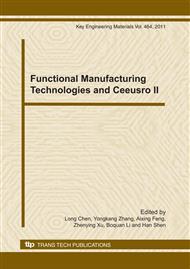p.556
p.560
p.564
p.568
p.572
p.576
p.583
p.588
p.592
The Effect of Process Parameters on Strain Rates in Laser Shock Forming
Abstract:
Laser shock forming (LSF) is characterized in non-contact load, high pressure and high strain ratio. It has many promising applications in aerospace, automotive, metal and many other industries. However, despite the extensive experimental and modeling study in literature, seldom investigations are about the effect of laser parameters on strain rates. With the variation of strain rates in LSF, the failure mechanism and plastic instability theory are different. Therefore, the variation of strain rates should be considered in the process of establishing LSF theory. Based on this, the article discussed the effect of laser shock parameters on the strain rates. Taken the 3003-H16 aluminum alloy as the specimen, the finite element (FE) analysis for LSF was performed.
Info:
Periodical:
Pages:
572-575
Citation:
Online since:
January 2011
Authors:
Price:
Сopyright:
© 2011 Trans Tech Publications Ltd. All Rights Reserved
Share:
Citation:


